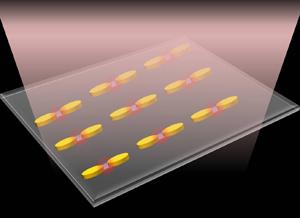Hot spots for molecules

Titanium pads (pink) placed in the ‘hot spots’ (red) between oval gold plates can be used to sense tiny amounts of molecules (blue). Copyright : © 2014 A*STAR Institute of Materials Research and Engineering
The ability to detect tiny quantities of molecules is important for chemical sensing as well as biological and medical diagnostics. In particular, some of the most challenging and advanced applications involve rare compounds for which only a few molecules may be present at a time.
The most promising devices for achieving ultrahigh-precision detection are nanoscale sensors, where molecules are placed in tiny gaps between small gold plates. But this method is effective only if the molecules are positioned accurately within the gaps. Now, Jinghua Teng from the A*STAR Institute of Materials Research and Engineering, Singapore, and colleagues from the National University of Singapore, have developed a sensor where molecules are efficiently guided and placed into position [1].
The electronic resonances occurring in gold nanostructures are like very powerful antennas, able to amplify radiation from small molecules in their vicinity. This permits even the detection of single molecules. In order for the signal to be picked up by the antennas, however, the molecules need to be precisely located within electromagnetic ‘hot spots’ (see image). “We approached this challenge and developed a method to selectively bind the molecules to the electromagnetic hot spots in the nanoantenna structure for maximum effect,” explains Teng.
The researchers needed to prepare the device surface such that the molecules bind only to the desired areas between the gold plates — not on them. They achieved this by depositing a thin titanium film between the gold plates. The titanium oxidizes in air, forming stable titanium dioxide, which is insulating and has very different properties to the gold plates.
The researchers then covered the surface with various organic solutions that selectively prevent proteins and other molecules from binding to the gold while attracting the molecules of interest to the titanium pad. In initial tests, signals from molecules attached to the titanium in the hot spot showed a six times higher sensitivity than those randomly attached across the device.
The next step will be to increase the sensor sensitivity to the ultimate limit, explains Teng. “People have been dreaming of and working toward single-molecule sensing. This work is part of these efforts. It provides a way to selectively bind biomolecules to the hot spots and proves that it can enhance the molecular sensitivity and reduce the amount of sample required.” Further improvements in device design will however be required, adds Teng. “Moving forward, we would like to further push the sensitivity by optimizing the structure and try multi-agent sensing in one chip.”
Reference
1. Zhang, N., Liu, Y. J., Yang, J., Su, X., Deng, J. et al. High sensitivity molecule detection by plasmonic nanoantennas with selective binding at electromagnetic hotspots. Nanoscale 6, 1416–1422 (2014).
Associated links
Media Contact
All latest news from the category: Materials Sciences
Materials management deals with the research, development, manufacturing and processing of raw and industrial materials. Key aspects here are biological and medical issues, which play an increasingly important role in this field.
innovations-report offers in-depth articles related to the development and application of materials and the structure and properties of new materials.
Newest articles

Silicon Carbide Innovation Alliance to drive industrial-scale semiconductor work
Known for its ability to withstand extreme environments and high voltages, silicon carbide (SiC) is a semiconducting material made up of silicon and carbon atoms arranged into crystals that is…

New SPECT/CT technique shows impressive biomarker identification
…offers increased access for prostate cancer patients. A novel SPECT/CT acquisition method can accurately detect radiopharmaceutical biodistribution in a convenient manner for prostate cancer patients, opening the door for more…

How 3D printers can give robots a soft touch
Soft skin coverings and touch sensors have emerged as a promising feature for robots that are both safer and more intuitive for human interaction, but they are expensive and difficult…





















